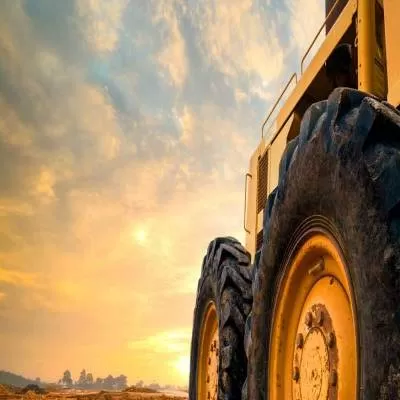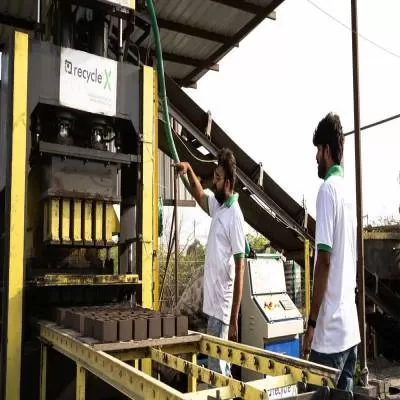- Home
- Real Estate
- Supporting Structures
Supporting Structures
The Indian formwork and scaffolding industry continues to evolve at an unprecedented pace. While bringing to light, trends, technological advances, safety and maintenance matters, Pia Sinha also explores the concept of equipment rental.
It goes without saying that against the backdrop of today's infrastructure and construction boom, the need for scaffolds and formwork is immense. While manufacturers of conventional and traditional systems catering to large, medium and small constructions seem to be doing brisk business, MNCs originating from Europe, UK and Australia also seem to be gathering force, having set up their bases in India to market and sell the concept of system for...mwork. The result: a growing emphasis on technologically superior systems comprising components of greater durability in the manufacture of scaffoldings and formwork.
Form matters
"The industry is changing rapidly," asserts Gary Joyce, CEO, Harsco Infrastructure India Pvt Ltd. "Within the scaffold industry, there is a greater emphasis on safety practices and scaffold designs, whereas in the formwork sector new technology is being used to speed up construction time, reduce labour and increase safety on site." Indeed, every construction project is extremely time-bound with additional value attributed to quality maintenance. "Formwork is crucial to construction activities and Indian manufacturers and traditional formwork are only able to cater to 40 per cent of the total formwork requirement in India," says V Radha Krishna, Director, Paschal Formwork (India). "This has, however, ensured opportunities aplenty for foreign scaffolding and formwork manufacturing companies to innovate and bring in the latest systems."
Horizontal and vertical formworks are composed of timber and steel components. "System formworks are also rampantly being enquired about by construction companies engaged in infrastructure and building projects, where criticality of the structure does not allow them to use conventional formwork systems," says Surajit Ray, Country Head, Ulma Formwork Systems India Pvt Ltd. The other factor of paramount importance is the time of completion and this demands a proven and effective formwork system to ensure faster construction progress at site.
Engineered formwork systems are built out of prefabricated modules with a metal frame consisting of steel or aluminium. The application (concrete) side is usually covered with material like steel, aluminium, plastic, timber, etc. The two major advantages of formwork systems, compared to traditional timber formwork, are speed of construction (modular systems pin, clip, or screw together quickly) and lower lifecycle costs. Barring a major force, the frame is almost indestructible. Interestingly, if the covering is made with steel or aluminium, the form can achieve up to 2,000 uses depending on care and application. Instead, if the covering is made of wood, steel or plastic, it may have to be replaced after a few, or a few dozen, or a few hundred uses.
"These systems are based on simple principles and can be used by contractors and labourers under the supervision of their engineers," adds Nunna Rao, Vice-President - Sales & Marketing, Pranav Construction Systems Pvt Ltd. "However, in order to ensure optimal use, we send our project engineers to sites to explain the best use of these systems and thus enhance value to our customers. It also helps in avoiding any mishaps owing to improper use of such systems at sites."
Technology and innovation
Today, companies are experimenting with new technology, materials and the like. "We are introducing," says Joyce. Also, Paschal India is employing new techniques and technology in the manufacture of these products. Its production plant is equipped with the latest CNC cutting machines to accurately cut plywood used in modular formwork panels while microprocessor-controlled welding machines are used for welding panels with absolute precision.
New techniques are being implemented to enhance performance and durability of the scaffoldings as well. "The unique combination of positive and rigid connection in a fast and non-bolted system permits the choice of automatically right-angled, linear or angled connections with built-in safety," says Mithilesh Kumar, Additional General Manager, Layher Scaffolding Systems Pvt Ltd. "The original Layher all-round scaffolding offers—particularly in complex scaffolding construction—an unmatched range of uses, unbeatably fast assembly, and persuasive economic arguments."
Better safe than sorry!
The construction industry is inherently hazardous and scaffolding accidents are common at construction sites. Many construction workers make use of scaffolding on a regular basis and many are hurt either by falling objects, slipping or support giving away. "It is crucial that the standards take in all aspects of the construction process with priority on safety, from initial design, type and use of materials, and structural loadings, through to actual working on site, erecting and stripping the systems," says Joyce.
In Kumar's view, "The loadings on scaffoldings should comply with the appropriate requirements of relevant Indian standards like the DIN ISO 9001 certification." For safety, adequate rigidity at all stages of erection and dismantling is also essential. The permissible stress and other design considerations should be in compliance with the appropriate requirements of relevant standards on structural design of tubular steel scaffolding. Erection and dismantling of scaffolding also need to be under the supervision of a competent authority with sound experience in scaffolding and false work.
"Regarding safety related to formwork, no specific regulations have been prescribed in India," says Ray. "But the essence lies in following the best engineering practice ensuring total safety while using the formwork." Aspects governing formwork standards are mainly the concrete pressure during pouring to be sustained by formwork system, weight of concrete to be suppor-ted by the formwork system and associated live loads, wind loads, etc. Further, aspects like firmness of panel joints, fixing clamps, lifting hooks fixity with panels and formwork panel fixity with support system need to be examined during inspection.
Maintenance issues
"Ranging between 100 and 300 repetitions for the more technologically upgraded systems, they compare much better to traditional materials that could be used for merely 10-12 repetitions," asserts Rao. And speaking of maintenance, he adds, "Formwork systems if used properly may not require much maintenance and could be used for many repetitions." Indeed rust on steel formwork in prefabrication plants could be the cause of much trouble and prove exceedingly costly to manufacturers of fair-face concrete units. Only an integral supervision of all possible causes would lead to a sustainable prevention of rust spots. With regard to scaffolds, regular lubrication and cleaning, proper storage and immediate repairing are sure to ensure longevity of equipment.
Renting out
In the ever-changing market, the best equipment to own is that which is versatile and useful, whatever the project at hand. "Even though steel scaffolding and formwork are expensive to buy, they are a great investment because they can be reused a number of times," says Kumar. "Moreover, in the Indian scheme of things, we notice a preference among contracting companies to buy equipment as opposed to renting." As far as the economic viability of renting equipment is concerned, it is observed that a minimum renting time of four months is made mandatory. Moreover, cost is also dependent on the number of repetitions of product usage. Of course, if you are good at operating and maintaining equipment, it may pay to add a specialised plant hire service to your contracting business.
So is the scaffolding and formwork industry being served well by its vendors? The answer is definitive: Yes, especially with the presence of sufficient Indian and multinational scaffolding and formwork companies providing solutions for all type of structures.
"Indian manufacturers and traditional formwork are only able to cater to 40 per cent of the total formwork requirement in India."- V Radha Krishna, Director, PASCHAL FORMWORK (INDIA)
"System formworks are crucial where the criticality of the structure does not allow the usage of traditional systems."- Surajit Ray, Country Head, ULMA FORMWORK SYSTEMS INDIA PVT LTD
"In order to ensure optimal use, we send our project engineers to sites to explain the best use of these systems."- Nunna Rao, Vice-President - Sales & Marketing, PRANAV CONSTRUCTION SYSTEMS PVT LTD
"The loadings on scaffoldings should comply with the appropriate requirements of relevant Indian standards like the DIN ISO 9001 certification."- Mithilesh Kumar, Additional General Manager, LAYHER SCAFFOLDING SYSTEMS PVT LTD
Quick Bytes:
• The scaffolding industry lays greater emphasis on safety practices and designs.
• System formworks use new technology to speed up construction time and reduce labour.
• Aluminium formwork systems are higher in strength than steel and much lighter to use.
• Erection and dismantling of equipment can be carried under the supervision of a competent authority.
- Construction
- Update
- Portal
- Magazine
- India
- October
- World
- 2010
- Formwork
- Scaffolding
- safety
- maintenance
- equipment
- rental
- infrastructure
- MNCs
- Europe
- UK
- Australia
- durability
- Gary Joyce
- Harsco
- V Radha Krishna
- Paschal
- Steel
- Surajit Ray
- Ulma
- prefabricated
- Nunna Rao
- Pranav
- contractors
- CNC
- machines
- modular
- welding
- Mithilesh Kumar
- Layher
- accidents
- Erection
- dismantling
- maintenance
- Aluminium
The Indian formwork and scaffolding industry continues to evolve at an unprecedented pace. While bringing to light, trends, technological advances, safety and maintenance matters, Pia Sinha also explores the concept of equipment rental. It goes without saying that against the backdrop of today's infrastructure and construction boom, the need for scaffolds and formwork is immense. While manufacturers of conventional and traditional systems catering to large, medium and small constructions seem to be doing brisk business, MNCs originating from Europe, UK and Australia also seem to be gathering force, having set up their bases in India to market and sell the concept of system for...mwork. The result: a growing emphasis on technologically superior systems comprising components of greater durability in the manufacture of scaffoldings and formwork. Form matters The industry is changing rapidly, asserts Gary Joyce, CEO, Harsco Infrastructure India Pvt Ltd. Within the scaffold industry, there is a greater emphasis on safety practices and scaffold designs, whereas in the formwork sector new technology is being used to speed up construction time, reduce labour and increase safety on site. Indeed, every construction project is extremely time-bound with additional value attributed to quality maintenance. Formwork is crucial to construction activities and Indian manufacturers and traditional formwork are only able to cater to 40 per cent of the total formwork requirement in India, says V Radha Krishna, Director, Paschal Formwork (India). This has, however, ensured opportunities aplenty for foreign scaffolding and formwork manufacturing companies to innovate and bring in the latest systems. Horizontal and vertical formworks are composed of timber and steel components. System formworks are also rampantly being enquired about by construction companies engaged in infrastructure and building projects, where criticality of the structure does not allow them to use conventional formwork systems, says Surajit Ray, Country Head, Ulma Formwork Systems India Pvt Ltd. The other factor of paramount importance is the time of completion and this demands a proven and effective formwork system to ensure faster construction progress at site. Engineered formwork systems are built out of prefabricated modules with a metal frame consisting of steel or aluminium. The application (concrete) side is usually covered with material like steel, aluminium, plastic, timber, etc. The two major advantages of formwork systems, compared to traditional timber formwork, are speed of construction (modular systems pin, clip, or screw together quickly) and lower lifecycle costs. Barring a major force, the frame is almost indestructible. Interestingly, if the covering is made with steel or aluminium, the form can achieve up to 2,000 uses depending on care and application. Instead, if the covering is made of wood, steel or plastic, it may have to be replaced after a few, or a few dozen, or a few hundred uses. These systems are based on simple principles and can be used by contractors and labourers under the supervision of their engineers, adds Nunna Rao, Vice-President - Sales & Marketing, Pranav Construction Systems Pvt Ltd. However, in order to ensure optimal use, we send our project engineers to sites to explain the best use of these systems and thus enhance value to our customers. It also helps in avoiding any mishaps owing to improper use of such systems at sites. Technology and innovation Today, companies are experimenting with new technology, materials and the like. We are introducing, says Joyce. Also, Paschal India is employing new techniques and technology in the manufacture of these products. Its production plant is equipped with the latest CNC cutting machines to accurately cut plywood used in modular formwork panels while microprocessor-controlled welding machines are used for welding panels with absolute precision. New techniques are being implemented to enhance performance and durability of the scaffoldings as well. The unique combination of positive and rigid connection in a fast and non-bolted system permits the choice of automatically right-angled, linear or angled connections with built-in safety, says Mithilesh Kumar, Additional General Manager, Layher Scaffolding Systems Pvt Ltd. The original Layher all-round scaffolding offers—particularly in complex scaffolding construction—an unmatched range of uses, unbeatably fast assembly, and persuasive economic arguments. Better safe than sorry! The construction industry is inherently hazardous and scaffolding accidents are common at construction sites. Many construction workers make use of scaffolding on a regular basis and many are hurt either by falling objects, slipping or support giving away. It is crucial that the standards take in all aspects of the construction process with priority on safety, from initial design, type and use of materials, and structural loadings, through to actual working on site, erecting and stripping the systems, says Joyce. In Kumar's view, The loadings on scaffoldings should comply with the appropriate requirements of relevant Indian standards like the DIN ISO 9001 certification. For safety, adequate rigidity at all stages of erection and dismantling is also essential. The permissible stress and other design considerations should be in compliance with the appropriate requirements of relevant standards on structural design of tubular steel scaffolding. Erection and dismantling of scaffolding also need to be under the supervision of a competent authority with sound experience in scaffolding and false work. Regarding safety related to formwork, no specific regulations have been prescribed in India, says Ray. But the essence lies in following the best engineering practice ensuring total safety while using the formwork. Aspects governing formwork standards are mainly the concrete pressure during pouring to be sustained by formwork system, weight of concrete to be suppor-ted by the formwork system and associated live loads, wind loads, etc. Further, aspects like firmness of panel joints, fixing clamps, lifting hooks fixity with panels and formwork panel fixity with support system need to be examined during inspection. Maintenance issues Ranging between 100 and 300 repetitions for the more technologically upgraded systems, they compare much better to traditional materials that could be used for merely 10-12 repetitions, asserts Rao. And speaking of maintenance, he adds, Formwork systems if used properly may not require much maintenance and could be used for many repetitions. Indeed rust on steel formwork in prefabrication plants could be the cause of much trouble and prove exceedingly costly to manufacturers of fair-face concrete units. Only an integral supervision of all possible causes would lead to a sustainable prevention of rust spots. With regard to scaffolds, regular lubrication and cleaning, proper storage and immediate repairing are sure to ensure longevity of equipment. Renting out In the ever-changing market, the best equipment to own is that which is versatile and useful, whatever the project at hand. Even though steel scaffolding and formwork are expensive to buy, they are a great investment because they can be reused a number of times, says Kumar. Moreover, in the Indian scheme of things, we notice a preference among contracting companies to buy equipment as opposed to renting. As far as the economic viability of renting equipment is concerned, it is observed that a minimum renting time of four months is made mandatory. Moreover, cost is also dependent on the number of repetitions of product usage. Of course, if you are good at operating and maintaining equipment, it may pay to add a specialised plant hire service to your contracting business. So is the scaffolding and formwork industry being served well by its vendors? The answer is definitive: Yes, especially with the presence of sufficient Indian and multinational scaffolding and formwork companies providing solutions for all type of structures. Indian manufacturers and traditional formwork are only able to cater to 40 per cent of the total formwork requirement in India.- V Radha Krishna, Director, PASCHAL FORMWORK (INDIA) System formworks are crucial where the criticality of the structure does not allow the usage of traditional systems.- Surajit Ray, Country Head, ULMA FORMWORK SYSTEMS INDIA PVT LTD In order to ensure optimal use, we send our project engineers to sites to explain the best use of these systems.- Nunna Rao, Vice-President - Sales & Marketing, PRANAV CONSTRUCTION SYSTEMS PVT LTD The loadings on scaffoldings should comply with the appropriate requirements of relevant Indian standards like the DIN ISO 9001 certification.- Mithilesh Kumar, Additional General Manager, LAYHER SCAFFOLDING SYSTEMS PVT LTD Quick Bytes: • The scaffolding industry lays greater emphasis on safety practices and designs.• System formworks use new technology to speed up construction time and reduce labour.• Aluminium formwork systems are higher in strength than steel and much lighter to use.• Erection and dismantling of equipment can be carried under the supervision of a competent authority.
























